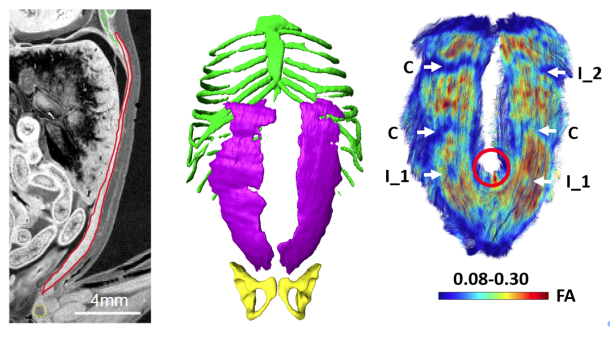
岩佐さんの腹直筋腱画についての論文がJ Anatomyに掲載されました。MRI_DTIを用いて腹直筋腱画形成過程を検討しました。
- 胎児期早期の腹直筋腱画形成過程について、数、大きさ、タイプ、側方性、性別による検討を拡散テンソル画像を用いて行った。
- 両側の腱性交差の平均数は3.1(範囲:2.0-4.0)であり、21%の検体では腱性交差は2つだけであった。
- 腱性交差の形成における帯状の違いは、これまでの成人の研究で観察されたものとほぼ一致していた。拡散テンソル画像は、腱性交差部形成の早期分化を検出することができ有用であった。
Iwasa Y, KanahashiT, ImaiH, OtaniH, YamadaS, Takakuwa T. Formation of tendinous intersections in the human fetal rectus abdominis, J Anatomy 2024, in press, DOI: 10.1111/joa.14064
Abstract
Previous studies have poorly described the initial development process of the tendinous intersections of the rectus abdominis muscle (RAM). The present study aimed to observe the formation of tendinous intersections in the RAM during the early fetal period using diffusion tensor imaging (DTI). Fifteen human fetal specimens (crown-rump length [CRL]: 39.5–93.7 mm) were selected. Three-dimensional measurements revealed that Zone-4 (i.e., the zone between the pubic symphysis and the caudal base of the umbilical ring in the RAM) had a smaller width and was thicker than Zone-1 and Zone-2 (i.e., the zones between the costal arch and the cranial base of the umbilical ring) and Zone-3 (i.e., the zone at the umbilical ring). Characteristics of tendinous intersections in the RAM during the early fetal period were assessed according to number, size, type, laterality, and sex. The mean number of tendinous intersections on both sides was 3.1 (range: 2.0–4.0), and 21% of specimens had only two tendinous intersections, which was higher than that reported in previous adult studies. The present data suggest that the formation of tendinous intersections was still in progress in specimens with two tendinous intersections in the RAM and that the third tendinous intersection was formed in Zone-2. Ordinal logistic regression via generalized estimating equations revealed that the odds for a higher type of tendinous intersections in Zone-1 and Zone-2 were significantly higher than those in Zone-4 (adjusted odds ratio: 14.85, 8.84). The odds for the presence of incomplete types (tendinous intersections that could not completely transverse the RAM) in Zone-3 were significantly higher than those in Zone-1 (adjusted odds ratio: 7.4). The odds for missing tendinous intersections in Zone-4 were significantly higher than those in Zone-1 (adjusted odds ratio: 20.5). These zonal differences in the formation of tendinous intersections were consistent with those observed in previous adult studies. In this study, DTI detected tendinous intersections in a sample with a CRL of 45.8 mm (approximately 11 weeks of gestation), which is earlier than that in previous histological findings, indicating that the RAM does not have mature tendinous intersections until the 17th week of gestation. In conclusion, DTI could detect the premature differentiation of tendinous intersection formation. Our data may aid in elucidating the developmental processes of tendinous intersections in the RAM.







